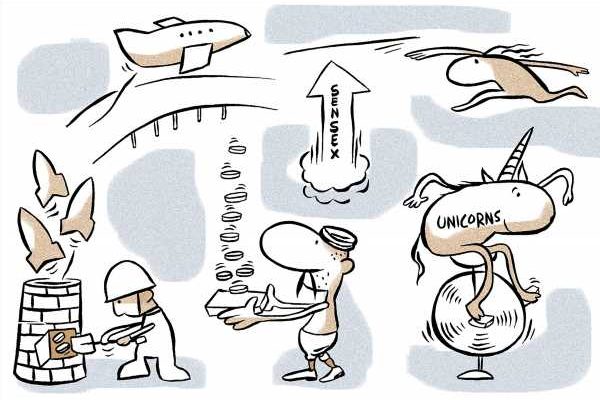In a country that is often focused on ways in which it falls short, the start of a year is a good time to remind oneself of such positives, observes T N Ninan.
Someone said the best thing about 2021 is that it is over.
That wry sentiment is understandable, even as there is dread about the viruses of the old year carrying over into the new.
Regardless, it would be a mistake to ignore the positives as one looks to a new year, starting with sport.
Not just cricket, in which India has arguably the best year-round, all-format team performance, but also the most promising performance at the Olympics to date.
The medal hall is admittedly still modest, but there is a revival in field hockey, a breakthrough in track and field, continuing strength in badminton, and promise (especially among women) in wrestling, weightlifting, shooting, archery, middle-distance running, and even golf.
There is a long way to go, especially in sports like football that require a combination of great strength and speed, plus stamina, and of course skill, so there is work to be done.
Then there is the stock market.
The Financial Times quotes MSCI indices to say that recent years have seen poor performance by stock markets in emerging economies, but that has not been true of India.
Indeed, there have been double-digit increases in Sensex values for three years running, the only such period since the financial crisis of 2008.
The third obvious positive is the country’s wealth of entrepreneurial talent. This is not new.
In the last three decades India produced first-generation entrepreneurs like Sunil Mittal and Uday Kotak, many leading lights in the software service and pharma sectors, and homegrown auto entrepreneurs like the Munjals.
These and others like them led the sectors that powered the broader economy forward.
It remains to be seen whether those in the forefront of today’s emerging sectors (electric vehicles, green energy, electronic goods manufacture, and retailing) and tech-driven unicorns prove to be worthy successors.
That depends on whether their enterprises are grounded in sound business logic and ethics – unlike those who in the last couple of decades led the charge, only to fail, in real estate, infrastructure, and aviation.
Fourth, one should mention the government’s largely unsuspected capacity to deliver targeted welfare benefits at scale, chiefly but not solely through the harnessing of technology.
Credit for this should go primarily to the prime minister, but also to the civil servants and tech entrepreneurs who have led the execution effort.
One wishes something similar could be done in quality basic education and in mass health care — the absence of which has held back the country.
Fifth, in a country with growing security challenges, the frustrating decades of trying to develop a viable defence production base have made way for a more successful phase.
The light combat aircraft has made it to production, as has the light combat helicopter.
India has turned out its first domestically-built aircraft carrier, is about to commission its second nuclear-powered submarine, and has developed a full-spectrum array of missiles.
These visible success stories have their foundation in a broad base of supplier companies, many of them in the medium and even small sector.
The production cycle in most of these is still very long, and must be shortened.
But from being the world’s second-largest importer of defence equipment, the country may now progress to being a significant producer as well.
Finally, we may in the next couple of years see the results of the long-haul investments in the country’s physical infrastructure, with the completion of the western high-speed railway freight corridor and better mobility with new expressways and highways.
The era of power shortages is already over (though the sector is still plagued by low tariffs), the telecommunication revolution is here, internet and mobile banking and other fintech services have simplified life for millions, flying is more affordable than ever, and we should soon see a new generation of faster, more comfortable passenger trains.
So the catchphrase ‘ease of living’ is beginning to acquire resonance.
In a country that is often or usually focused on the ways in which it falls short, the start of a year is a good time to remind oneself of such positives.
Feature Presentation: Aslam Hunani/Rediff.com
Source: Read Full Article

